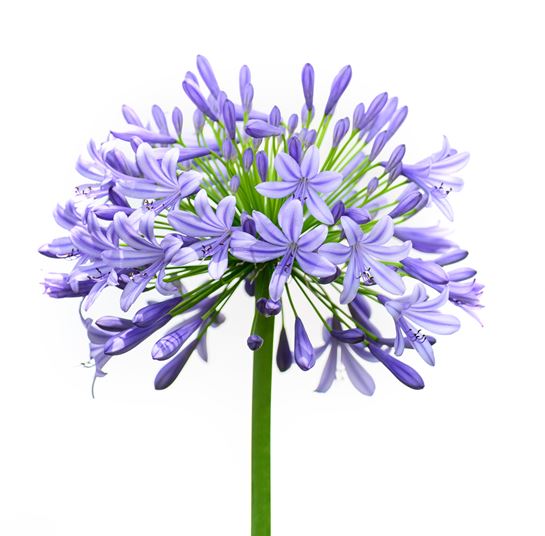How to Plant and Maintain Agapanthus in Your Garden
Wiki Article
Understanding the Art of Agapanthus Care: Necessary Steps for Healthy Growth and Vivid Blossoms
In the realm of cultivation, the cultivation of agapanthus stands as a gratifying venture for those who seek to nurture these classy flowering plants. With their striking flowers and graceful foliage, agapanthus has actually captured the focus of garden enthusiasts worldwide. Nonetheless, attaining optimum growth and dynamic blossoms calls for a nuanced approach that incorporates various essential actions. From picking the appropriate selection to grasping pruning strategies, the journey towards cultivating flourishing agapanthus plants is diverse and holds the vital to opening the complete potential of these herb gems.
Choosing the Right Agapanthus Selection

When selecting the best Agapanthus range for your garden, think about aspects such as environment viability, flower color, and development habit. Agapanthus, typically called Lily of the Nile or African lily, can be found in a selection of shades varying from tones of purple and blue to white. Select a flower color that matches your existing garden combination to create a harmonious landscape. Additionally, consider the climate in your region to guarantee the Agapanthus range you choose can grow in your specific problems. Some selections are a lot more forgiving of chilly temperatures, while others favor warmer environments. Comprehending the growth routine of various Agapanthus selections is essential for appropriate positioning within your yard. Some selections have a clumping development practice, ideal for containers or boundaries, while others have an even more dispersing nature, ideal for ground cover or mass growings. By carefully evaluating these factors, you can choose the perfect Agapanthus variety to boost the beauty of your garden.
Perfect Growing Conditions
Taking into consideration the ideal environmental needs is important for effective Agapanthus farming. Agapanthus plants are sensitive to chilly temperature levels and ought to be shielded from frost during wintertime months.To guarantee healthy and balanced growth and vibrant blossoms, plant Agapanthus bulbs at a deepness of concerning 2-4 inches and space them 8-12 inches apart. Mulching around the base of the plants helps keep wetness and subdues weed development.
Watering and Feeding Tips
Keeping appropriate wetness levels and giving crucial nutrients are crucial elements in the treatment routine for Agapanthus plants. When it comes to watering Agapanthus, it is essential to strike a balance. These plants like continually wet soil yet are vulnerable to root rot if overwatered. During the growing season, water deeply as soon as a week, ensuring the dirt is well-draining to stop waterlogging. In hotter environments or during durations of dry spell, even more regular watering may be necessary to maintain the dirt uniformly moist. Nonetheless, lower watering in the wintertime to avoid water logged conditions.Fertilizing Agapanthus is important for promoting healthy and balanced development and respected blossoms. Use a well balanced plant food, such as a 10-10-10 formula, in the very early spring as brand-new growth emerges. Repeat this application every 6-8 weeks throughout the expanding period. Stay clear of too much fertilizing, as it can lead to lush foliage at the expense of blossoms. Constantly follow the manufacturer's instructions for appropriate dilution and application methods. By complying with these watering and fertilizing ideas, you can guarantee your Agapanthus plants grow and generate vibrant, durable flowers.
Pruning Techniques for Agapanthus
Trimming Agapanthus plants at the proper times and with correct methods is vital for maintaining their health and advertising optimal development and blooming. The excellent time to prune Agapanthus remains in late click this link wintertime or early springtime prior to brand-new growth emerges. Begin by removing any dead or yellowing leaves near the base of the plant. Cut them as short as possible without harming the emerging shoots.For flowered stems, wait until the blossoms have withered and afterwards trim them back to the base. This not just cleans the plant's look yet likewise motivates the growth of brand-new blossom buds. Deadheading spent flowers can also reroute the plant's power into producing even more blossoms as opposed to setting seeds. However, if you intend to gather seeds for propagation, leave some flowers to dry and fully grown on the plant.
Bear in mind to utilize clean, sharp tools to make precise cuts and reduce the danger of presenting illness. Agapanthus. Regular trimming will certainly assist maintain your Agapanthus looking cool and healthy while making certain a bountiful display screen of beautiful blooms
Handling Common Bugs and Conditions
After guaranteeing correct trimming strategies for Agapanthus, it is essential to attend to common insects and diseases that can affect the health and vigor of these plants. One typical pest that affects Agapanthus is the Agapanthus gall midget.Additionally, Agapanthus plants can suffer from origin rot if they are planted in inadequately draining pipes soil. By being attentive and taking timely action against insects and conditions, you can help your Agapanthus plants thrive and create vibrant blooms. Agapanthus.

Final Thought
Finally, understanding the art of agapanthus care involves selecting the ideal variety, supplying ideal growing problems, proper watering and fertilizing, appropriate trimming methods, and dealing with usual insects and illness. By adhering visit our website to these important steps, you can make certain healthy and balanced development and lively blossoms for your agapanthus plants. Bear in mind to consistently monitor and preserve your plants to promote their general well-being and long life.To guarantee healthy and balanced growth and vibrant flowers, plant Agapanthus bulbs at a depth of about 2-4 inches and area them 8-12 inches apart. By following these watering and fertilizing ideas, you can guarantee your Agapanthus plants prosper and produce lively, long-lasting blooms.
One usual bug that impacts Agapanthus is the Agapanthus gall midget. Additionally, Agapanthus plants can experience from root rot if they are planted in inadequately draining soil. By adhering to these important actions, you can ensure healthy and balanced growth and dynamic blooms for your Going Here agapanthus plants.
Report this wiki page